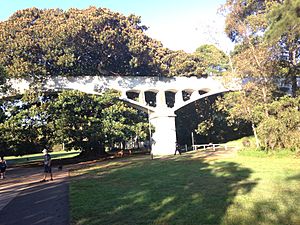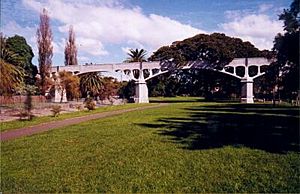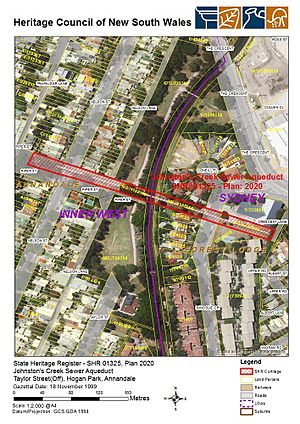Johnston's Creek Sewer Aqueduct facts for kids
Quick facts for kids Johnston's Creek Sewer Aqueduct |
|
|---|---|

Johnston's Creek Sewer Aqueduct, looking south
|
|
| Location | off Taylor Street, Hogan Park, Annandale, Inner West Council, Sydney, New South Wales, Australia |
| Built | 1897 |
| Architect | William Julius Baltzer (Public Works Department) |
| Owner | Sydney Water |
| Official name: Johnston's Creek Sewer Aqueduct; Johnstons Creek Sewer Aqueduct | |
| Type | state heritage (built) |
| Designated | 18 November 1999 |
| Reference no. | 1325 |
| Type | Sewage Aqueduct |
| Category | Utilities - Sewerage |
| Builders | Public Works Department |
| Lua error in Module:Location_map at line 420: attempt to index field 'wikibase' (a nil value). | |
The Johnston's Creek Sewer Aqueduct is a special bridge in Annandale, Sydney, Australia. It was built a long time ago, in 1897, to carry sewage across a valley. This important structure was designed by William Julius Baltzer, an engineer from the NSW Public Works Department.
Today, it is owned by Sydney Water and is recognized as a heritage site. It was added to the New South Wales State Heritage Register on 18 November 1999.
Contents
A Bridge for Waste: How It All Started
The Johnston's Creek aqueduct was built in 1897. It was part of a bigger system called the Northern Main Sewer. This sewer helped carry wastewater from busy areas like Balmain, Annandale, and Glebe.
The sewer needed to cross two valleys: Johnston's Creek Valley and White's Creek Valley. This was a big project for the time. The goal was to get the sewage to the Bondi Ocean Outfall Sewer.
Designing a New Kind of Bridge
The design for this section of the sewer started in 1895. Engineers first thought about using concrete and brick arches. But they changed their minds.
They decided to use a new method called "reinforced concrete." This was a very modern building technique for the late 1800s. The contract for this new design was given in mid-1896.
The engineer who designed it was W. J. Baltzer. He worked for the Department of Public Works. Baltzer had studied in Germany. He also worked with a company called Carter Gummow & Co. This company held the rights for the "Monier system."
The Monier system was a special way to use reinforced concrete. This method helped make concrete structures much stronger.
Building the Aqueduct
The aqueduct was designed to carry a U-shaped sewer pipe. This pipe was about 1 meter (3 feet 6 inches) wide and 1.37 meters (4 feet 6 inches) tall. It was made from reinforced concrete.
The pipe is held up by many reinforced concrete arches. There are 8 large arches, each about 25 meters (81 feet 10 inches) wide. There are also smaller arches at the eastern end. The whole structure is about 281.6 meters (924 feet) long. Each arch rests on strong concrete bases called piers.
In the mid-1980s, the aqueduct was repaired. A plastic liner was put inside the sewer pipe. The arches are still in good condition today.
What the Aqueduct Looks Like
The aqueduct is a series of thin, strong concrete arches. These arches hold up the concrete sewer pipe. They sit on large concrete piers that cross Hogan Park. Johnstons Creek's stormwater channel flows through the park below.
On the western side, near Nelson Street, there is a concrete retaining wall and public stairs. The aqueduct then crosses the shallow valley of Johnstons Creek. It continues to the eastern end near Taylor Street.
The aqueduct is a very noticeable feature in Hogan Park. There's even a large fig tree close to one of the main arches. Its branches spread over the sewer pipe.
Why It's a Heritage Site
The Johnston's Creek sewer aqueduct was finished in 1897. It is a very important and visible part of Sydney's old sewer system. The aqueduct's arches and pipe were some of the first big structures in New South Wales to use reinforced concrete. It was also one of the first in all of Australia.
The slim shape of its arches and sewer pipe, along with its historical value, make it a major landmark in Sydney. It is a key part of the local area's history and has been part of the park for a long time. Its important features include its park setting, its building technology, and its continued use.
The Johnston's Creek Sewer Aqueduct was added to the New South Wales State Heritage Register on 18 November 1999 for several reasons:
- It shows important history: The aqueduct is linked to engineer W. J. Baltzer and the company Carter Gummow & Co. They were pioneers in using reinforced concrete in Australia. This aqueduct was a major part of the Northern Main Sewer, which helped bring sewage services to inner-western suburbs like Balmain, Annandale, and Glebe.
- It shows great design and skill: The aqueduct is a striking feature in Leichhardt and Forest Lodge. Its length, height, and slender design make it an impressive sight and a landmark in Sydney.
- It has social importance: The aqueduct helps people in the local area understand their history. It is recognized by groups like the National Trust of Australia (NSW) and Engineers Australia.
- It can teach us about history: This aqueduct was one of the first major structures in NSW and Australia to use reinforced concrete. Studying it can help us learn about how this building method developed.
- It is rare: It is rare in Australia because of how much reinforced concrete was used and how early it was built.
- It represents its type: While unique in its construction, its function (carrying sewage) is common across Sydney.
Engineering Heritage Recognition
The aqueduct has received a Historic Engineering Marker from Engineers Australia. This is part of their Engineering Heritage Recognition Program. This marker celebrates important engineering achievements.



